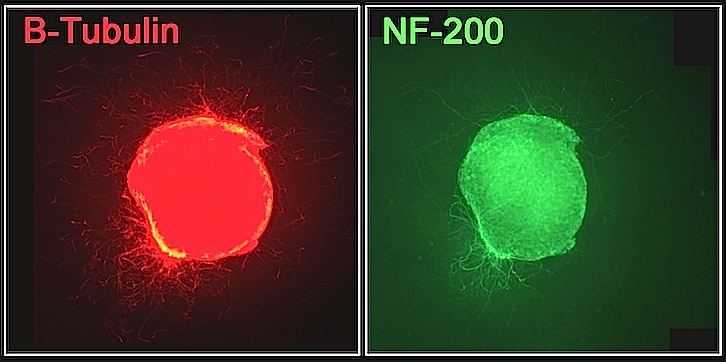Regulation of sensory nerve fibres regeneration after an injury

After a peripheral nerve injury, neurons activate mechanisms that allow the cell to return to a pro-regenerative state and regrow the sectioned axons, so that they can reinnervate and reconnect to the peripheral targets in order to recover their function.
However, in most cases the regeneration of sensory axons is neither quantitatively nor selectively efficient enough with regard to the various categories of sensory information processing (touch, temperature, pain, etc.), resulting in insufficient recovery and functional alterations in the processing of information, particularly as neuropathic pain.
|
|
|
| Figure 1: Administration of Bumetadine (inhibitor of sodium, potassium and chloride type 1 (NKCC1) co-transporter activation) specifically and selectively affects the regeneration of myelinated sensory fibres. | |
In addition, our results show that the activation of a subtype of mitogen-activated kinases (MAPKs), specifically the c-Jun N-Terminal kinases (JNKs), after the injury is the mechanism responsible for the regulation of the co-transporter NKCC1.
In summary, this study demonstrates that the modulation of specific kinases – the JNKs – can selectively alter the growth and regeneration of sensory nerve fibres, opening a new avenue for research to improve functional recovery following peripheral nerve injuries.
Department of Cell Biology, Physiology and Immunology – UAB
Centro de Investigación Biomédica en Red sobre Enfermedades Neurodegenerativas (CIBERNED)
References
Mòdol, Laura; Santos, Daniel; Cobianchi, Stefano; González-Pérez, Francisco; López-Alvarez, Víctor; Navarro, Xavier. NKCC1 activation is required for myelinated sensory neurons regeneration through JNK-dependent pathway. Journal of Neuroscience. 2015, vol. 35, num. 19, p. 7414-7427. doi: 10.1523/JNEUROSCI.4079-14.2015.


